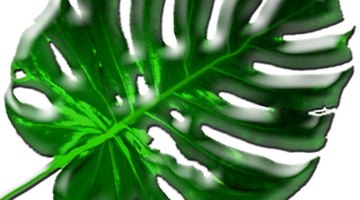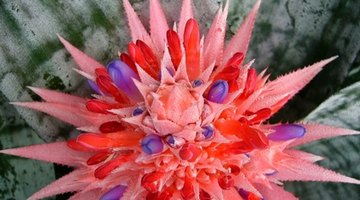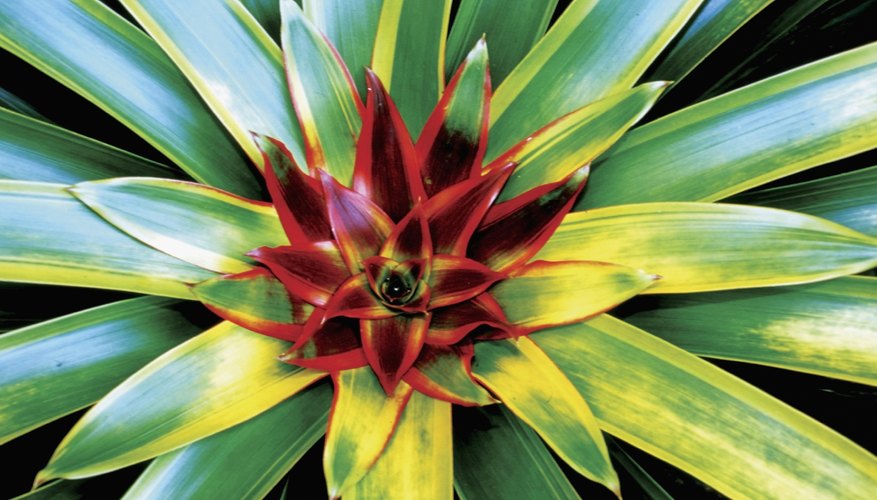South American forests are home to many plant species, including most of the world's bromeliads and many orchids.The Amazon rainforest alone holds some 40,000 plant species according to the World Wildlife Fund website. South American forests have been the source for many of the world's cultivated, tropical species, such as the anthuriums and the monstera or Swiss cheese plant. Many South American plants can be grown as houseplants or even outdoors in frost-free areas.
Monstera

The monstera or Swiss cheese plant (Monstera deliciosa) is a tropical forest liana that has large leaves with deep slits and oblong holes. People commonly grow it as a houseplant or a frost-free garden plant. Given space to climb, monstera vines can grow to 70 feet but are normally small in cultivation. The flower is upright and white and the fruit aromatic and edible.
- The monstera or Swiss cheese plant (Monstera deliciosa) is a tropical forest liana that has large leaves with deep slits and oblong holes.
- Given space to climb, monstera vines can grow to 70 feet but are normally small in cultivation.
Bromeliads

Bromeliads are a large family of plants. Many grow as epiphytes on the trunks and branches of tropical forest trees. Since its roots are used for gripping, most bromeliads absorb water and nutrients directly through their leaves. Bromeliads can be grown as houseplants or outdoors in frost-free areas. They produce colourful spikes of long-lasting flowers.
- Bromeliads are a large family of plants.
- Bromeliads can be grown as houseplants or outdoors in frost-free areas.
Pineapple

The pineapple (Ananas comosus) is the only bromeliad to produce an edible fruit. It grows a rosette of long, stiff leaves up to six feet high with toothed margins. The fruit grows from the centre of the rosette up to 24 months after planting. Pineapple plants can be propagated from suckers or by planting the spray of leaves on top of a ripe pineapple fruit.
- The pineapple (Ananas comosus) is the only bromeliad to produce an edible fruit.
- The fruit grows from the centre of the rosette up to 24 months after planting.
Allamanda
Allamanda (Allamanda cathartica) is a tropical climbing vine. It can be grown as a creeper or a free standing shrub. It produces large, trumpet-shaped, yellow flowers during the summer. Allamanda grows fast but is not very hardy and benefits from having its growing tips pinched out to encourage branching. All parts of the allamanda plant are poisonous.
- Allamanda (Allamanda cathartica) is a tropical climbing vine.
- Allamanda grows fast but is not very hardy and benefits from having its growing tips pinched out to encourage branching.
Anthuriums

There are some 800 species of Anthurium or tail flower native to the tropical forests of South and Central America and many hybrids in cultivation. Some species grow on tree trunks and branches and others on the forest floor. Anthuriums are grown for their large, heart-shaped leaves and colourful flowers. Long-lasting anthurium blooms can be white, pink or red and have a distinctive, broad spathe and long, narrow spadix. They are damaged by temperatures below 10 degrees Celsius and grow well in the shade.
- There are some 800 species of Anthurium or tail flower native to the tropical forests of South and Central America and many hybrids in cultivation.
- Long-lasting anthurium blooms can be white, pink or red and have a distinctive, broad spathe and long, narrow spadix.
Acai Palm
The acai palm (Euterpe oleracea) grows up to 60 feet high and grows along river banks of the South American tropical forests. It produces bunches of purple fruits about an inch across with a layer of oily fruit surrounding a large stone. The fruits form an important part of the diet of forest residents and are collected and exported in frozen or freeze dried form due to their high concentrations of antioxidants.
